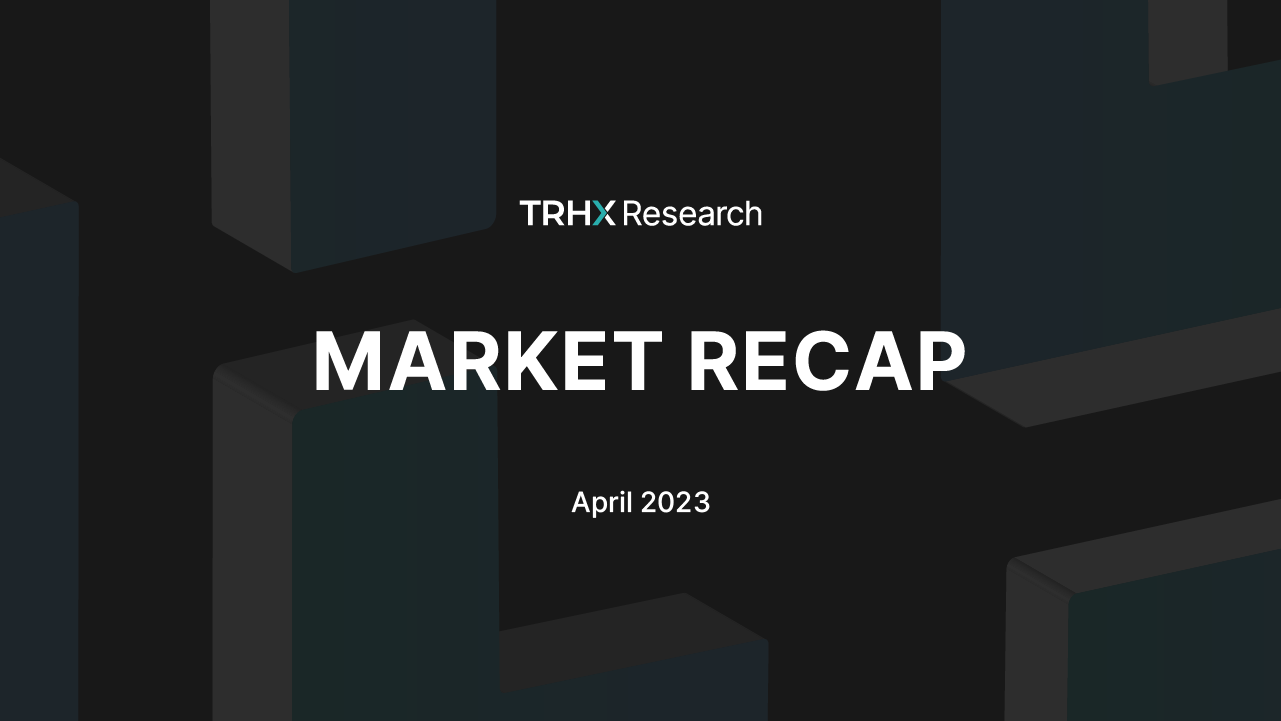What are the key themes that drove the crypto market this April? While the much-awaited Ethereum Shapella upgrade was completed on 12 April, the majority of the largest winners of April were driven by other catalysts such as product developments, partnerships, and the upgraded tokenomics models. Despite sticky inflation and credit woes, the crypto market has held its ground, with Bitcoin and altcoins holding steady. As we move into May, let’s explore the leading narratives of the crypto market in April. Catch up on previous months’ winning narratives with our monthly market recaps at TRHX Research.
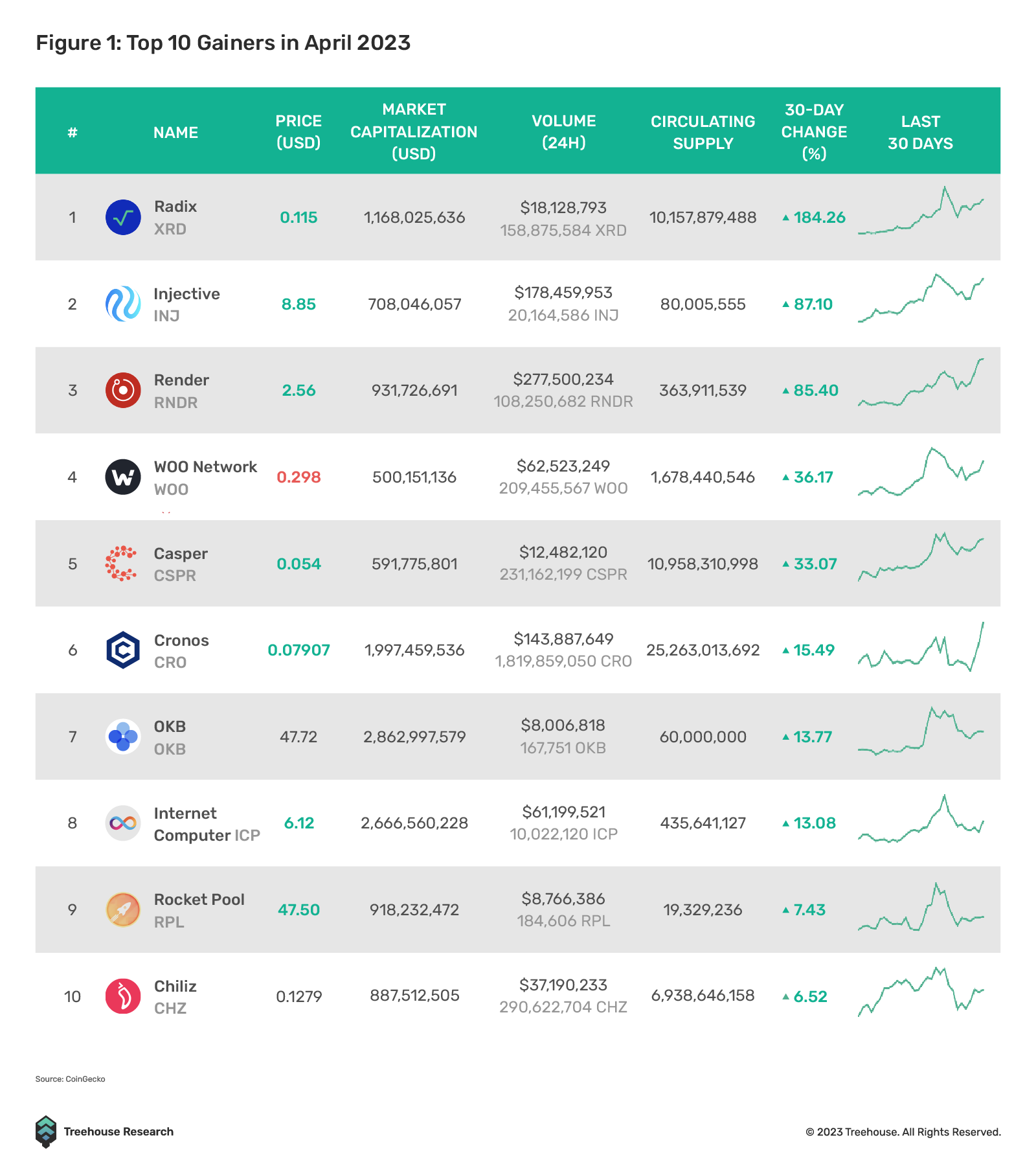
Radix (XRD)
XRD took the crown as the top winner in the last month with a 184% gain. The pump was largely driven by the Radix mainnet upgrade, also known as Babylon. The upgrade introduced smart contract capabilities to the blockchain which was the most important upgrade on Radix’s roadmap to date.
The Babylon upgrade was highly anticipated by the community for a while now, with Radix reporting more than 50 projects queued up for smart contract deployment since last month. Some of these projects include decentralized exchanges (DEXs) that have already gained significant volume and successful projects that have already been deployed on other Layer-1s (L1s) and Layer-2s (L2s).
As a result of the upgrade completion, the team announced that the developer activities on the blockchain surged significantly. According to the data shared by the Radix team, the network had merely 140 developers in February 2022. This number soon reached 2,072 in June 2022, and 8,532 in February 2023, marking a remarkable 5,994% annual increase.
What’s more, Radix announced a partnership with LayerZero, further boosting the return of its native token, XRD. LayerZero is an intra-blockchain interoperability protocol that has gained significant traction as a promising protocol that has yet to release its native token. It will help Radix’s L1 network to enable cross-chain communication and asset transfer.
Injective (INJ)
As the runner-up gainer in April, Injective’s 87% gain was largely driven by external partnerships. Four strategic partnerships were formed with the protocol in one month, continuously boosting investor confidence in its native token, INJ.
The first partnership was announced at the start of April when Injective partnered with rollup provider Eclipse to launch the first Sealevel Virtual Machine (SVM). The SVM partnership will allow Solana smart contracts to be deployed directly onto the Injective blockchain network, incorporating interoperability between chains. With the integration, the founder of Eclipse Labs expects to bring enormous developer activities into Injective and, more broadly, the overall Cosmos ecosystem.
On 19 April, Injective announced the partnership with Tencent Cloud, the cloud arm of Tencent, the biggest Chinese company by market capitalization. While the market did not react to this bullish partnership, it has long-term implications as developers on Injective can now enjoy access to Tencent’s cloud infrastructure, which could attract more to build and join Injective’s hackathon event.
Two days later, Injective announced its integration with Apollo Safe, becoming the first multi-signature protocol deployed on the Injective mainnet. As a decentralized smart contract-based multisig wallet, Apollo Safe brings an extra layer of security to the ecosystem, laying the foundation for more users to join the ecosystem
Lastly, the most recent partnership announcement came on 25 April, where Injective integrated with Celer Network, an interoperability protocol that allows for asset transfers across multiple L1s. As of now, the Celer bridge supports 150+ tokens with well-known assets such as Astar and Polkadot. The partnership was perceived to be highly bullish as the market rallied 16.5% within 12 hours following the announcement.
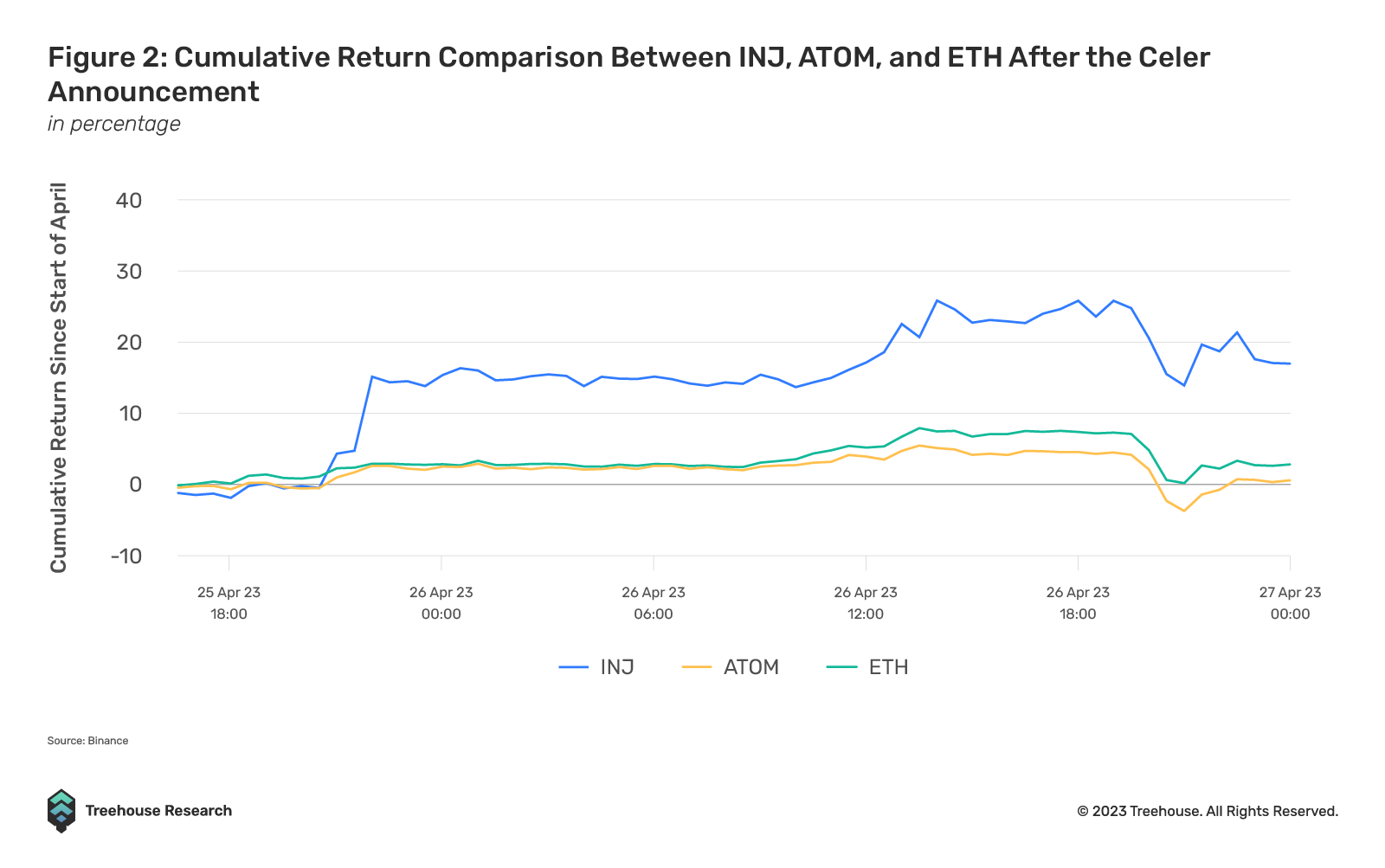
Render (RNDR)
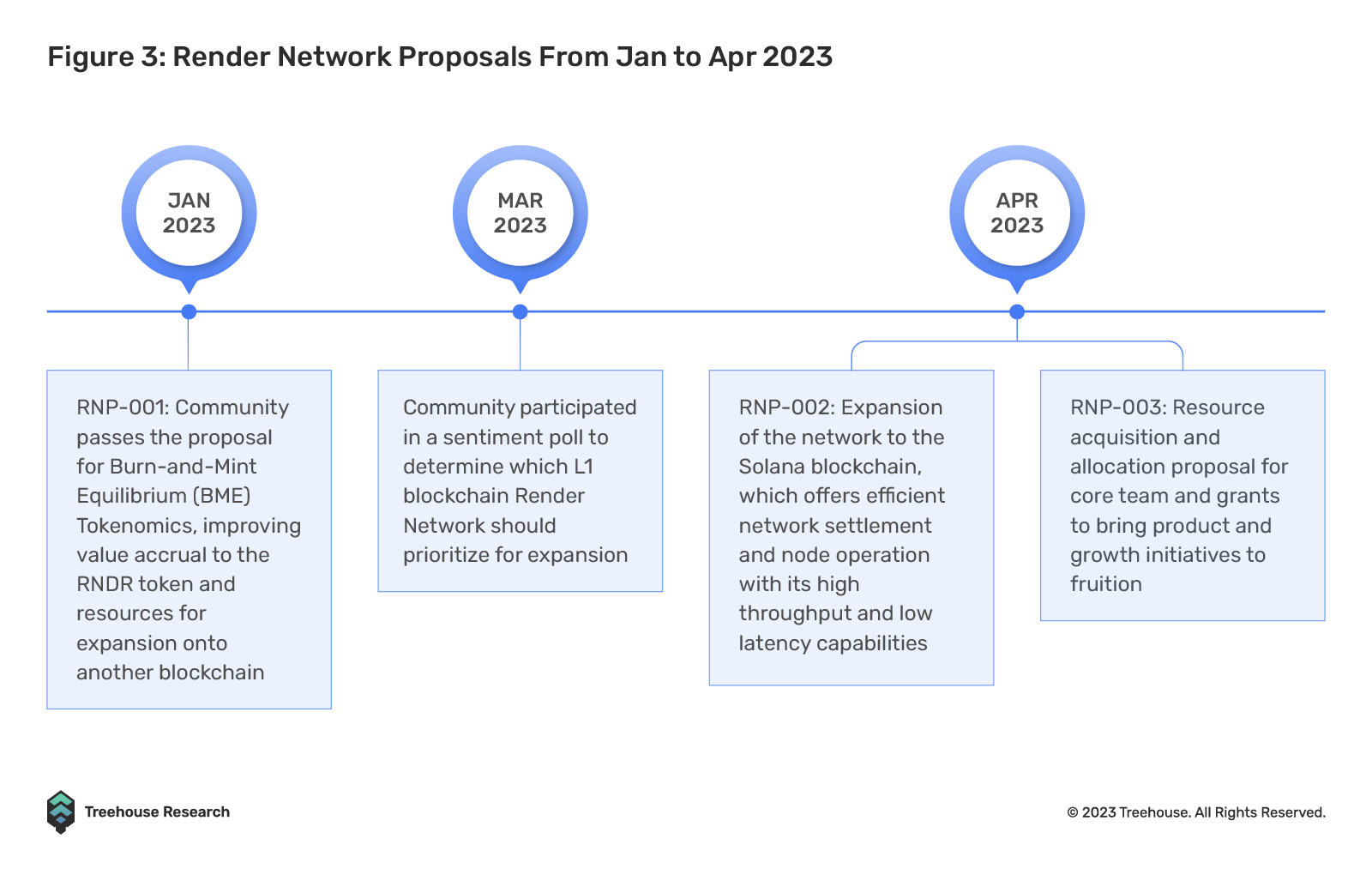
RNDR experienced a significant gain of 85.40%, making it one of the top-performing assets in the past month. This surge is mainly attributed to the series of Render Network Proposals (RNP) passed in 2023, including the network’s expansion to the Solana blockchain.
In January, RNP-001 introduced an updated tokenomics model, known as the Burn-and-Mint Equilibrium (BME). This model aims to increase the value of the RNDR token as a commodity asset based on the usage and growth of the Render Network. Under the BME model, users must burn RNDR tokens equivalent to the dollar value of the job request they submit to the network. Node operators receive token emissions, which are adjusted based on the network’s growth requirements.
RNP-001 also proposed that the Render Network Foundation invest resources to expand onto another blockchain. In April, RNP-002 was passed, allowing the network to expand to the Solana blockchain. This has boosted sentiment surrounding Render Network, as the community views Solana positively as a base for the network. In addition, RNP-003 was also passed to allocate funds to the Render Network Foundation for the core team and grants, supporting growth initiatives across the ecosystem.
The recent growth in Artificial Intelligence (AI) technologies has also contributed to Render Network’s positive performance. Render Network is a distributed GPU rendering network that connects artists and studios with mining partners for rendering and CPU computing power. It has gained a lot of attention from investors looking to leverage its potential as an “infrastructure play” due to its ability to facilitate decentralized GPU processing between providers and requestors. Users can rent, offer, and utilize GPU resources to handle complex tasks that require significant computing power, such as rendering videos or running AI.
Woo Network (WOO)

WOO has experienced a remarkable 36.17% price increase over the past month, largely due to its growing adoption and revamped tokenomics. On the DeFi side, WOOFi Swap has quickly adapted to the L2 narrative by supporting zkSync Era and Base testnets. It has also achieved a record-breaking 7-day trading volume of US$196M, with 100M staked WOO tokens in Q1, attributed to an influx of new users, deeper integration with Stargate, and upgrades to WOOFi’s cross-chain swaps.
On the CeFi side, WOO Network is undergoing a strategic shift to make WOO X one of the most robust trading platforms globally. This transition is driven by enhancements to its fee structure and staking program, which aims to better align incentives across all ecosystem participants. This includes more rebate incentives to compensate ambassadors, affiliates, and brokers for bringing users and trading volume to WOO X. Additionally, taker fees on perpetual futures markets will facilitate rebates to incentivize more market makers to support liquidity on the platform.
Lastly, WOO Network has made a series of improvements to the tokenomics of its WOO token to increase utility and transparency for the community. The most notable change is the burn of 705M WOO tokens, representing about 24% of the maximum supply. At the same time, WOO Ventures, WOO DAO, and the insurance fund were wound down in an effort to pivot on WOO Network’s strategy to bring value to the ecosystem. In addition, a large portion of the remaining ecosystem tokens will be placed into time-locked vesting contracts for more complete transparency and clarity around token supply.
Casper (CSPR)
Casper gained 33.1% in April. Majority of the gain seemed to be due to the hype around the new Casper browser wallet launched on 12 April. After launching the wallet, CSPR proceeded to spike from US$0.042 to US$0.057 in just three days.
The new Casper Wallet was a collaborative effort between Casper Association, Casper Labs, and MAKE, a consultancy firm. This wallet is the third product in the CSPR product suite following the introduction of CSPR.live, the blockchain explorer, and CSPR.studio, an NFT marketplace. With the new CSPR wallet, users can now have support for desktop browser and mobile notifications delivery with enhanced UIUX and security.
Other notable developments include Casper Labs joining the World Economic Forum (WEF) Global Innovator Community on 4 April to educate the public on blockchain’s current and potential applications. Casper Labs also participated in CoinDesk’s Consensus 2023 event from the 26 to 28 April.
Cronos (CRO)
Cronos made the top 10 list towards the last few days of April. On 26 April, Amazon Web Services (AWS) posted on Linkedin that it teamed up with Cronos Labs to aid the Web3 sector through the Cronos Accelerator Program. Through this program, participants can access the Cronos communities, including the Crypto.com application and exchange, and receive mentorship from industry experts and potential investments from industry partners.
While Amazon is not a Web3-native company, it has continuously tried incorporating its businesses into the Web3 landscape. Specifically, Amazon is reportedly planning to launch an NFT marketplace called “Amazon NFT Marketplace” or “Amazon Digital Marketplace” with 15 initial collections available to US customers.
As a result, the market reacted highly positively to the news with CRO, the native token for the Cronos chain, spiking 13% in price following the announcement. With the market pump in mid-April due to Shapella, CRO recorded a 15.5% gain in April.
OKB (OKB)
OKB is the exchange token for OKX, which benefits CEX users through trading fee discounts, access to OK Jumpstart Initial Exchange Offering (IEO) platform, and the ability to vote on tokens listing. Throughout April, the token experienced significant price appreciation due to its involvement in the Sui token sale, causing a 13.8% surge in its price. The token attracted users to participate in a lottery to purchase SUI at US$0.10, and they could subscribe to up to 10K SUI paid in OKB. Additionally, OKX has set aside an additional 25M SUI tokens for white-listed users who can purchase up to 1.5K SUI priced at $0.03, a 70% discount to the lottery price.
Although the launch of the SUI mainnet was postponed, the demand for OKB loans skyrocketed following the official launch of the SUI subscription on 23 April. The annualized interest rate of OKB loans surged to a high of 331% as users loaned a total of 109M $OKB tokens in the span of a day, indicating significant hype surrounding the SUI launch.
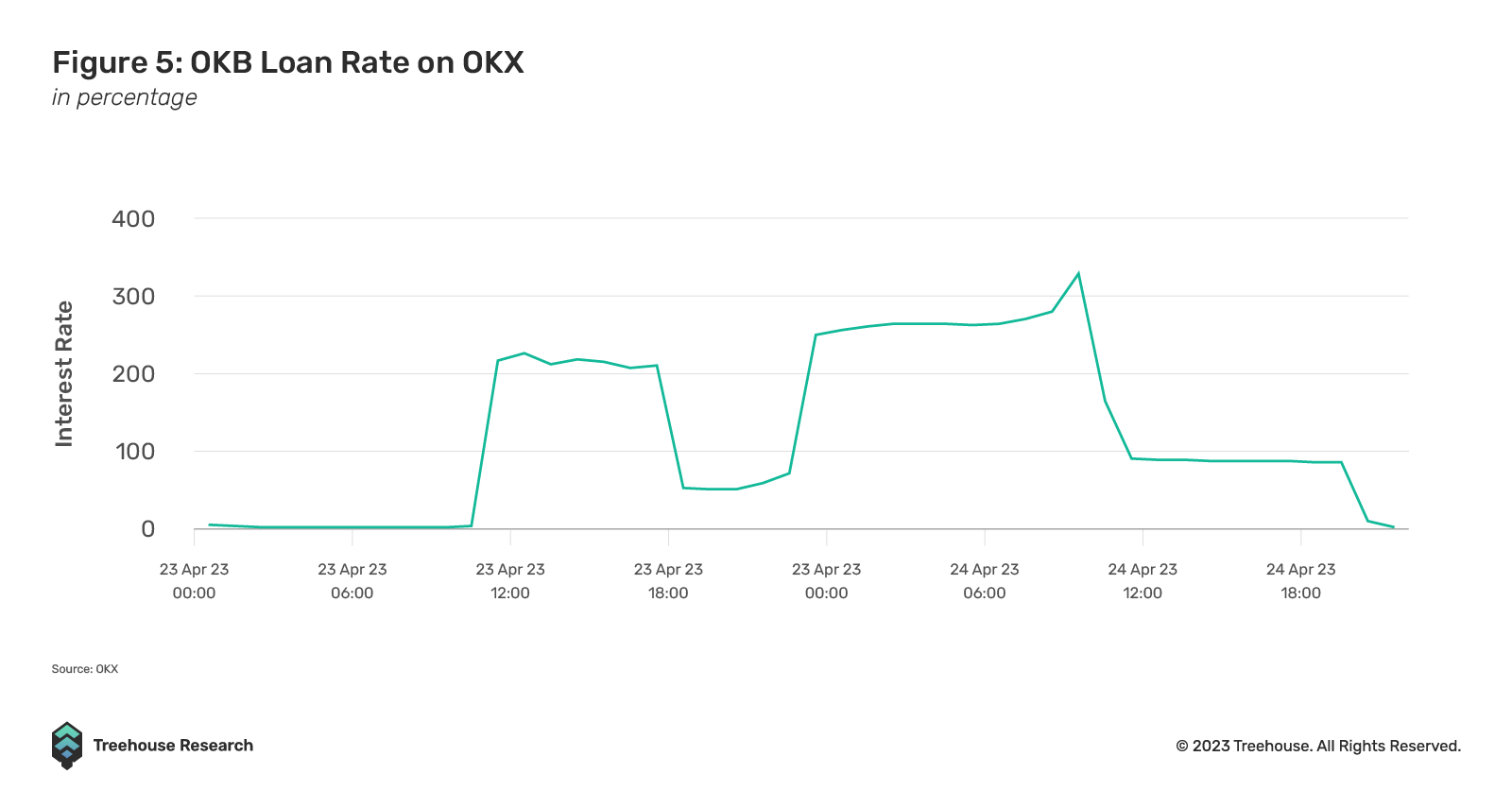
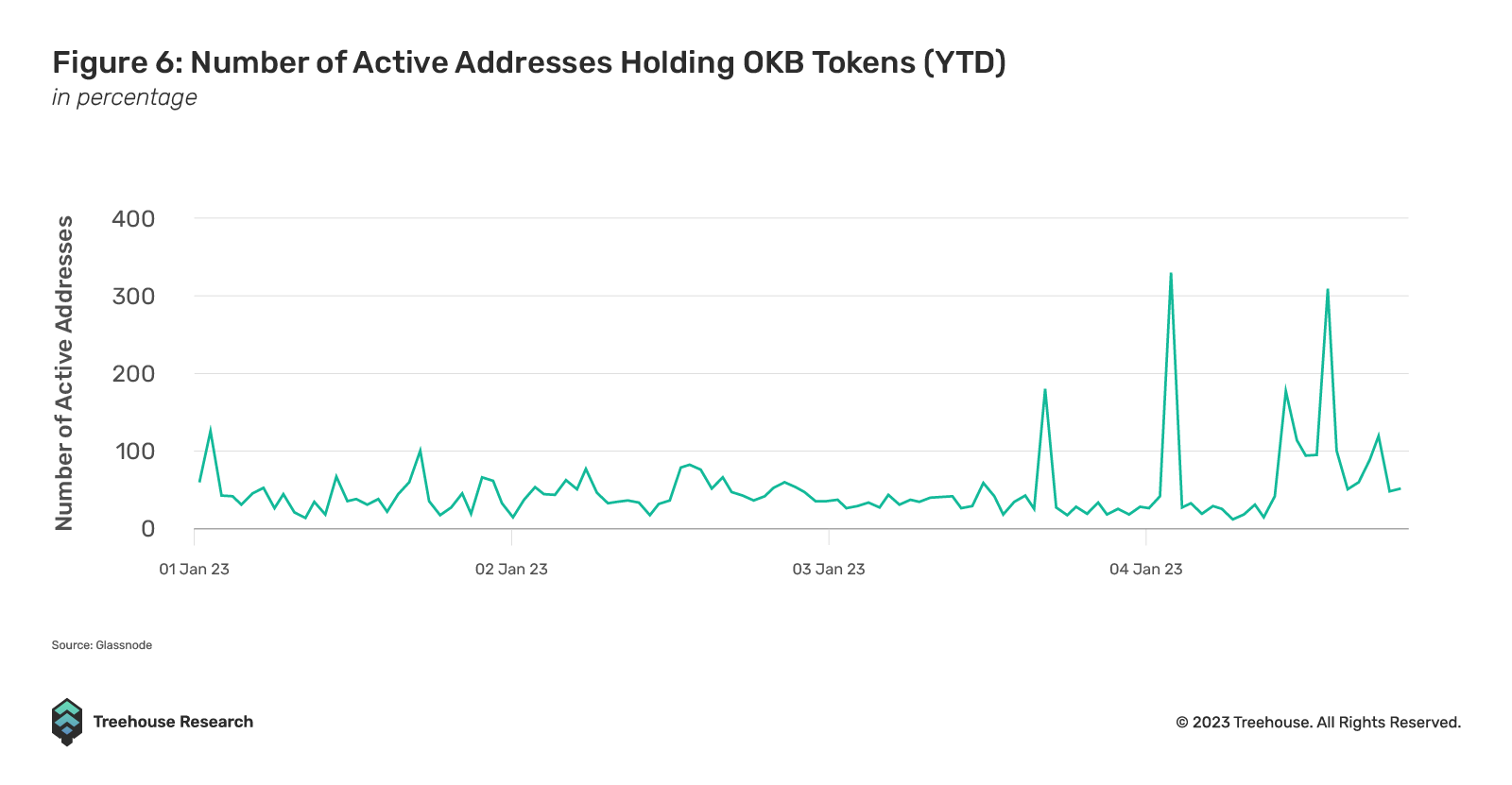
On the other hand, despite the surge in OKB price and trading volume, the number of active addresses holding OKB tokens has remained relatively unchanged, reaching a high of 330 since the start of the year, according to data from Glassnode. Nonetheless, OKX has recorded a net inflow of ~US$400M in assets, steadily climbing in the last 30 days.
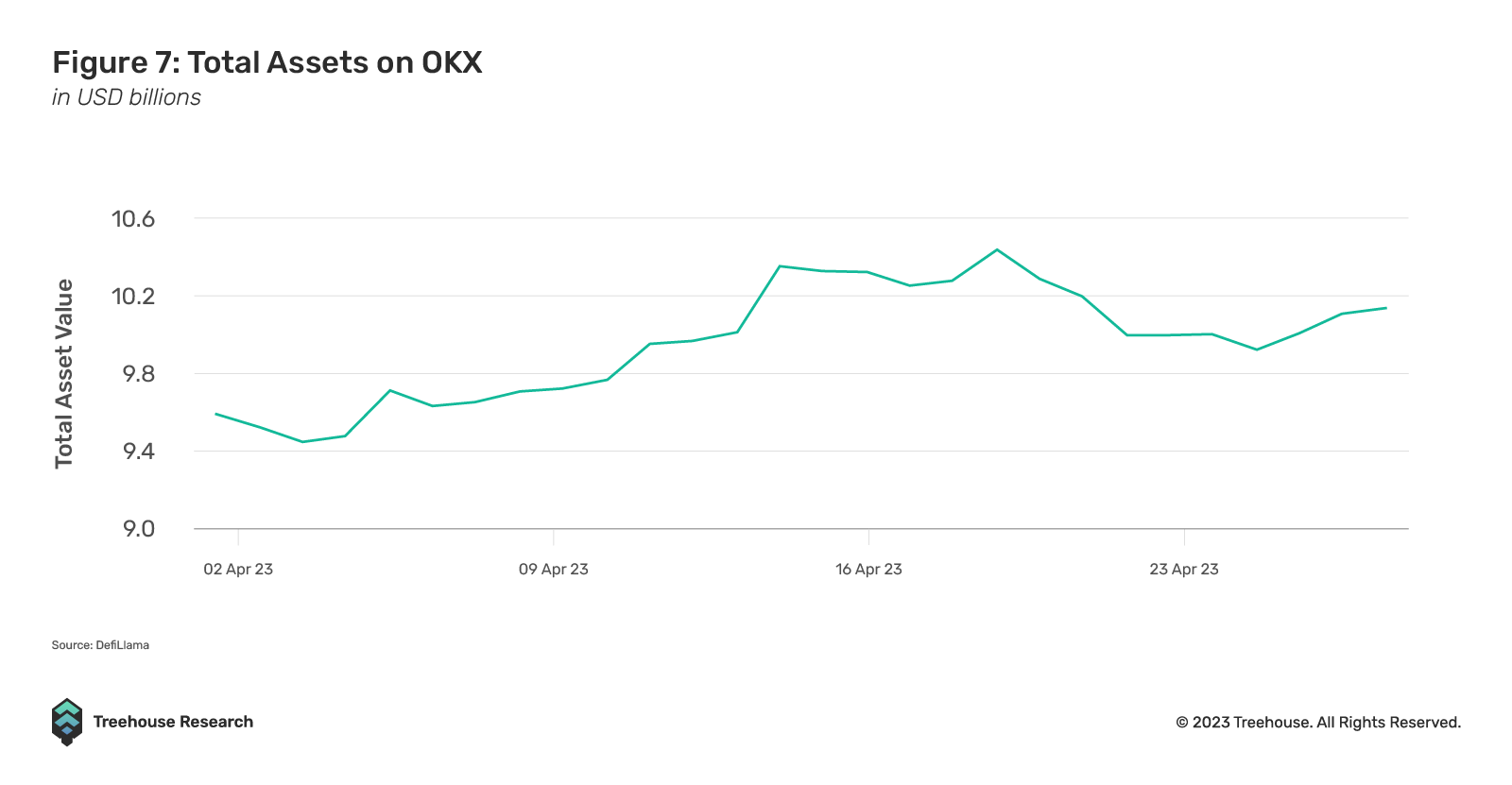
Lastly, OKB’s top performance can also be attributed to the hype around the soon-to-be-launched OKB Chain, which went live on a testnet in late March. The new chain will be an L2 Ethereum scaling solution using zero-knowledge rollup (ZKR) technology. Unlike other rollups, the transaction fees on the chain will be paid in OKB instead of ETH, making it more appealing to traders to amass OKB in the near term, contributing to its price rise.
Internet Computer (ICP)
The pump of ICP was largely driven by the continuation of the China/HK narrative in the past few months. After the Hong Kong Web3 Festival, Dominic Williams, the founder of Definity, the company behind Internet Computer, tweeted that the company plans to create an Internet Computer Hub in Hong Kong and form an ICP Asia Alliance together with VCs to build on ICP. Pumping with the market during those few days, this tweet on 19 April generated significant traction, leading to ICP outperforming the market, shown by its continued increase even when the market cooled down from the previous pump.

RPL pumped 7.4% from the Shapella upgrade on 12 April, hitting an all-time high (ATH) of US$59.30 on 16 April. There seemed to be two primary reasons for this pump. The first is the liquid staking derivatives (LSDs) narrative that institutional interest will increase with the decrease in staking risks through the activation of withdrawals. Secondly, Rocket Pool seemed to be attracting investors due to their continued efforts towards decentralization through their Atlas Upgrade.
On 18 April, Rocket Pool implemented the Atlas upgrade, lowering the requirements of node operators from 16 to 8 ETH. This greatly reduces the barriers to entry and would allow for greater decentralization with more node operators. Since the upgrade, the number of LEB8 Minipools created currently sits at 4K, with another 2.3K in the queue due to high demands. The trajectory of the amount of ETH staked headed higher, increasing from 452.76K to 534.67K, marking an 18% increase in two weeks.

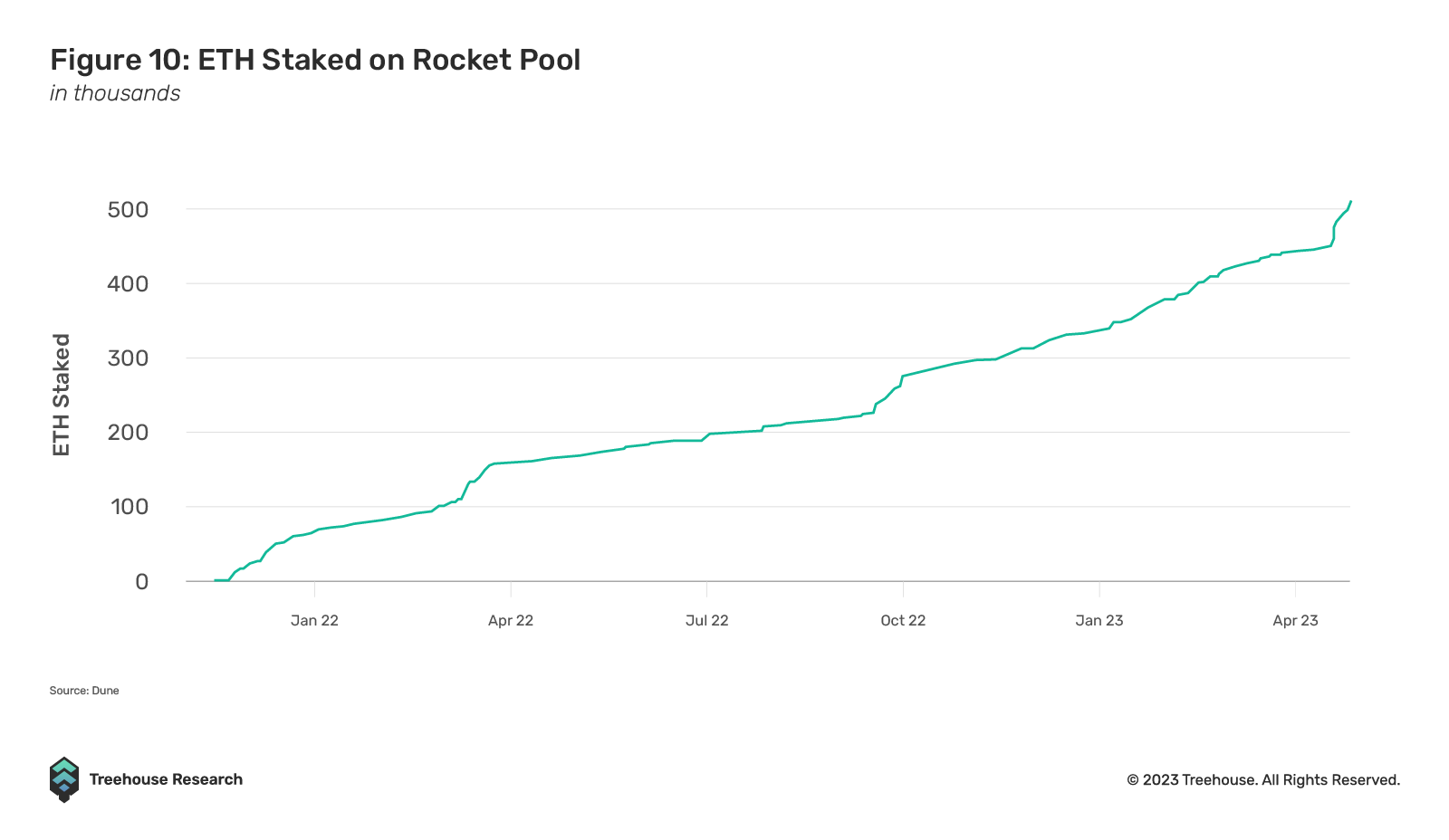
Chiliz (CHZ)
Lastly, in the 10th spot, CHZ recorded a 6.5% gain in the last month. While this is relatively in line with market returns, the overperformance of CHZ, the native token of Chiliz, may be attributed to investor expectations on its upcoming L1 blockchain – the Chiliz chain.
Specifically, Chiliz uses blockchain technology to power the Socios fan token ecosystem by engaging fans in the world of sports and entertainment. These fan tokens give fans the ability to vote in proportion to their ownership and grant them exclusive benefits like discounts, promotions, and content. Additionally, fans can compete with each other by testing their sports knowledge, with the chance to win prizes such as signed club merchandise.
On 18 and 19 April, the Chiliz team announced burns of a series of fan tokens. The official launch date of its blockchain was also announced to be 10 May, driving up investor sentiments toward the upcoming blockchain.
Verdict
This concludes our April market recap of the top 10 gainers’ narratives. The crypto market has remained resilient in the face of economic uncertainties. April also provided some clarity around interest rate hikes as investors anticipate that the Fed will likely make a final rate hike in May. With the Merge wrapped up, we look forward to seeing how new narratives will surface in the coming months.
Disclaimer
This publication is provided for informational and entertainment purposes only. Nothing contained in this publication constitutes financial advice, trading advice, or any other advice, nor does it constitute an offer to buy or sell securities or any other assets or participate in any particular trading strategy. This publication does not take into account your personal investment objectives, financial situation, or needs. Treehouse does not warrant that the information provided in this publication is up-to-date or accurate.

Hyperion by Treehouse reimagines workflows for digital asset traders and investors looking for actionable market and portfolio data. Contact us if you are interested! Otherwise, check out Treehouse Academy, Insights, and Treehouse Daily for in-depth research.
